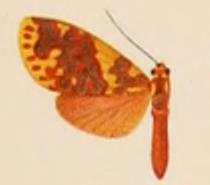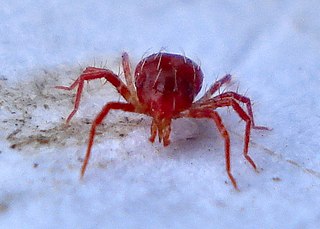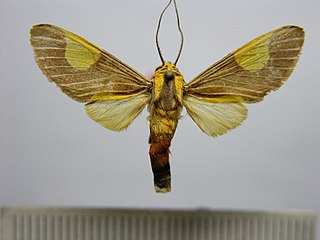
The true frogs, family Ranidae, have the widest distribution of any frog family. They are abundant throughout most of the world, occurring on all continents except Antarctica. The true frogs are present in North America, northern South America, Europe, Africa, and Asia. The Asian range extends across the East Indies to New Guinea and a single species has spread into the far north of Australia.

Aradus is a genus of true bugs in the family Aradidae, the flat bugs. It is distributed worldwide, mainly in the Holarctic. There are around 200 or more species in the genus.

Schinia, commonly called flower moths, is a large genus of moths belonging to the family Noctuidae. The genus has a Holarctic distribution with the vast majority of species being found in North America, many with a very restricted range and larval food plant.
Nyctimystes persimilis, also known as the Milne big-eyed treefrog, is a species of frog in the family Pelodryadidae, also treated as the subfamily Pelodryadinae in the family Hylidae. It is endemic to Papua New Guinea and known from Mount Dayman and Mount Simpson in the Owen Stanley Range.
Craugastor persimilis is a species of frog in the family Craugastoridae. It is found in the lowlands and premontane Atlantic slopes of central to southeastern Costa Rica. Its natural habitats are lowland and premontane moist rainforest. It lives in leaf-litter and can persist in moderately disturbed areas, including plantations. It is an adaptable species that is not considered threatened, despite severe habitat fragmentation within its range.
Alastor is a Palearctic, Indomalayan and Afrotropical genus of potter wasps.

Palpita is a genus of moths of the family Crambidae. Members of the moth genus Stemorrhages may be very similar in appearance.

Catocala persimilis is a moth of the family Erebidae first described by Warren in 1888. It is found in western India.
Schinia persimilis, the persimilis flower moth, is a moth of the family Noctuidae. The species was first described by Augustus Radcliffe Grote in 1873. It is found from in western North America from east central Alberta and the Cypress Hills in Saskatchewan north to the southern Yukon, west and south to Colorado, Utah, California and Oregon.
Hadena persimilis is a species of moth of the family Noctuidae. It is found in the Balkans, the European part of south-eastern Russia, Ukraine, Turkey, Israel, Armenia, Azerbaijan, Iran, Turkmenistan and Kazakhstan.
"Hylarana" persimilis, commonly known as the Sumatra frog, is a species of true frogs in the family Ranidae. It is native to Aceh, Sumatra, Indonesia. It is only known from the holotype collected from a lakeside.

Trichromia persimilis is a species of moth from the family Erebidae first described by Walter Rothschild in 1909. It is found in French Guiana, Brazil, Peru and Suriname.

Acaricomes phytoseiuli is a bacterium which is thought to be a pathogen of the mite Phytoseiulus persimilis. A. phytoseiuli causes a set of symptoms in the mite, known as nonresponding syndrome or NR syndrome. Dramatic changes in longevity, fecundity, and behavior are characteristic with this disease. The bacteria accumulate in the lumen of the mite's digestive tract and cause extreme degeneration of its epithelium. Infection with A. phytoseiuli greatly reduces the mite's attraction to herbivore-induced plant volatiles, and the mite is more prone to leave patches with ample prey. The disease is transmitted horizontally by means of feces and debris. The strain that was isolated was “CSC”. Differences between strain CSC compared to its closest phylogenetic neighbors are as follows: CSC uses glucose-1-phosphate and L-glutamic acid, and its colonies are more yellow in appearance as compared to its phylogenetic neighbors which are more cream/white in color.
Drosophila persimilis is a species of fruit fly that is a sister species to D. pseudoobscura, and was one of 12 fruitfly genomes sequenced for a large comparative study.

Rhipha persimilis is a moth in the family Erebidae. It was described by Walter Rothschild in 1909. It is found in Costa Rica, French Guiana, Ecuador and Peru.

Hestina persimilis, the siren, is an East Palearctic species of siren butterfly (Apaturinae) found in western China, Simla to Assam, Orissa. The larva feeds on Celtis australis.

Antigona is a genus of saltwater clams, marine bivalve molluscs in the family Veneridae, the venus clams.
Neanura persimilis is a species of springtail in the family Neanuridae.
Chlorochroa persimilis is a species of stink bug in the family Pentatomidae. It is found in North America.

Crataegus persimilis is a species of hawthorn, known by the common names plumleaf hawthorn and broad-leaved cockspur thorn, native to southern Ontario, Canada, and the US states of New York, Pennsylvania, Ohio, Kentucky, West Virginia, and Virginia. It is widely cultivated, particularly in Europe, as an ornamental. Its sporadic distribution in its natural range and certain of its morphological characters leads authorities to consider it a probable naturally occurring hybrid, with its most likely parents being Crataegus succulenta and Crataegus crus-galli. It is a tetraploid. Some populations may be self-perpetuating. Its 'Prunifolia' cultivar has gained the Royal Horticultural Society's Award of Garden Merit, and is considered one of its top 5 trees for smaller gardens.








